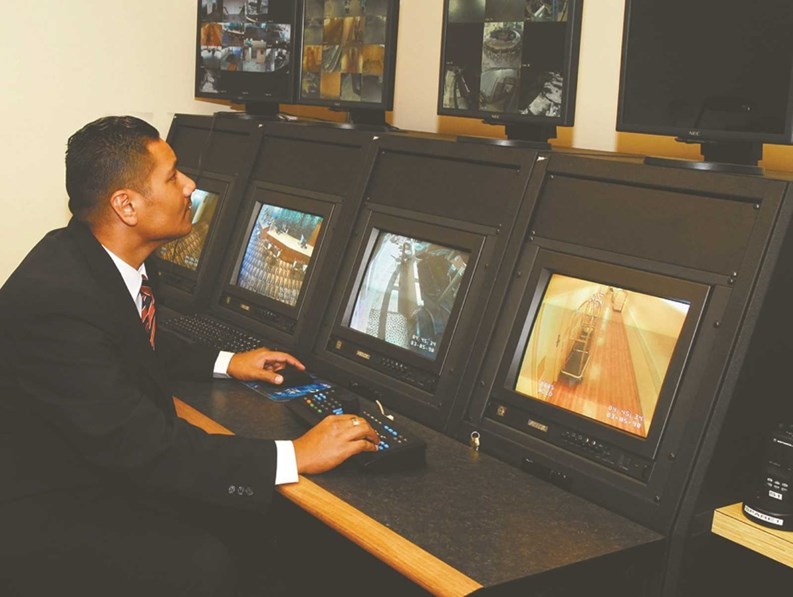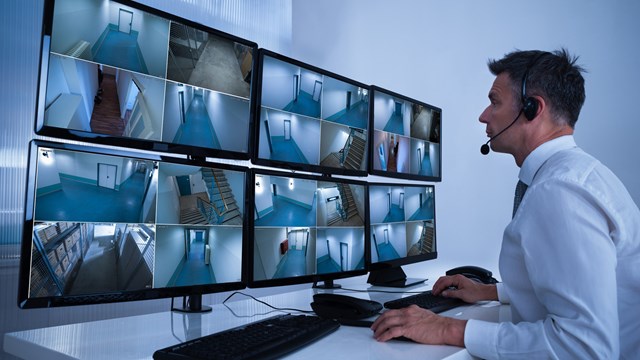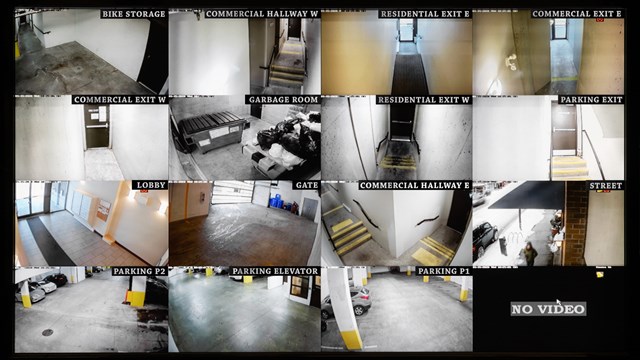Not so long ago, if you wanted to know who was on your stoop, you stuck your head out the window and asked who was there. But these days, the demand for greater security and the evolution of technology has led to the availability of systems that not too many years ago were purely in the realm of science fiction. Things like biometric scanners and time-sensitive key cards are in use every day in residential buildings around New York City and are becoming more widespread.
As these security systems have become more widely used, the cost of many of them has declined. Some of these systems are now affordable enough that they can be customized for smaller buildings with fewer residents and more modest resources. Newer systems can also often be integrated into a building’s existing security system, giving the benefit of added security at a relatively small cost. Taking advantage of the available options starts with assessing a building’s security system to determine what sort of upgrade makes the most sense.
Voice to Video
Many residential buildings in New York have older security systems that use phones or intercoms as the primary communication between residents and visitors. Telephone-based systems are a good starting point from which to begin a security upgrade, since the existing components can often be switched out for newer parts.
Resident demand has driven buildings to change from voice-only security systems to a much heavier use of video intercoms, says Larry Dolin, president/CEO of American Security Systems in Long Island City.
“Even with an actual doorman, a lot of times residents want to see the visitor,” Dolin says. “Everybody wants to go to video so they can see the person coming in, and also see them in the vestibule and in the elevator.”
According to Dolin, residential buildings that already have a telephone system in place often can have a video security system installed for a relatively manageable cost. For a 20-unit building, it might cost up to $30,000 to install an audio/video surveillance system from scratch, but buildings that already have a security system with cameras can be upgraded to a more advanced “cyber” or “virtual” doorman system for a relatively small cost—as little as $3,000 for some places.
“For buildings with a camera security system, we install an inexpensive recorder and an inexpensive security system,” says Seth Barcus, vice-president of Bronx-based Cyberdoorman. “Because of the recession, people want to protect their assets, and there are less expensive methods to achieve the same security.”
Using the Web
As with so many aspects of daily living—such as cell phones, high-definition TV and text messaging—the Internet has enabled notable advances in security. “Cyber” doorman systems are one way the Web can be used to provide more security for residential buildings. With such systems, the “doorman” actually is a security company person using the system to remotely view those who enter and exit the building, and sometimes to view those traversing the building’s hallways and common areas.
Cyber doorman systems enable monitors to screen anyone seeking access to the building remotely, by either viewing them on camera or speaking with him through the security system’s phone or both. Certain people—friends, relatives, dog-walkers, babysitters, and cleaning personnel, for example—can be pre-approved by a resident and OK’d for regular building access. The Internet is certainly not infallible—servers can crash, and wireless communication links can sometimes be disrupted by rain or other inclement weather. To address these occasional glitches, Web-based security systems are usually installed with a redundancy protocols. For example, Cyberdoorman installs upgraded systems, but leaves the phone lines intact, Barcus says. “We keep the audio portion of the phone calls over the regular phone line. Because the phone is analog, it’ll work even if the digital does not.”
Manhattan-based Virtual Doorman is another computerized doorman system that can service up to 125 apartments, and it can easily be retrofitted into existing buildings, according to Colin Foster, vice president of sales and marketing for Virtual Doorman. The web-based system also includes account management features and streamlined communication that connects residents with the command center and their building management. Residents can log into a website portal that allows them private access to input their own personal information. They can also log in to find out what happened last week or two months ago, Foster said. Residents can also provide a passcode for family members, friends or guests. Management staff can also control building functions, maintenance requests and provide residents with emergency contacts through the Web portal. The system can be customized based on each individual building’s profile, said Foster. Formerly limited to telephone and email communication, residents can alert the Virtual Doorman system about guests that will be arriving, what packages or deliveries are expected, and any other activities that require attention and access to the building. The Web portal will allow for efficient handling of requests, enhanced event logging capabilities, improved communications between residents and management, (sort of like a building bulletin board) and real-time guest and delivery management.
Unlike having a real person behind a desk, virtual systems also can have a setup in which packages can be left in a secure room in the building, from which residents can pick up parcels at their convenience. Dry cleaning, UPS packages, food deliveries and other regular deliveries to residents can be safely picked up by residents still in their slippers. Such conveniences enable residents of a telecommuting world to have both security and flexibility. In buildings located in higher-crime areas, residents whose buildings have a cyber doorman system can be sure that visitors to their building are being screened by the remote operators of the system. All of the activity caught by the system’s cameras also is digitally recorded, making storage and viewing of the footage much easier and less expensive than in the days of VHS recording.
Buildings can also opt to install what's often called a “video escort” function to their security package. With such a service, the system is equipped with transmitter fobs that residents activate when they go into their building. When activated, the video escort enables the remote security operator to view the resident as he or she walks through the building to the apartment door—keeping an eye out for their safety.
Reading Digits
While lock-and-key security systems still are in use in most buildings, that method of securing one’s home and valuables—especially in an apartment building—becomes less secure over time. The reason for this is obvious: over time, more and more people have access to keys for the building. Keys could be with the old girlfriend of a resident, or they might be in the hands of former residents, or with former building security and maintenance personnel who no longer should have access to the place. Security professionals advise changing the locks and keys in your building every few years to maintain a basic level of access security.
A newer system seeing increasing use in residential buildings is key card access. Key card systems have been used for years in hotels and are on the rise in residential buildings because they alleviate the necessity of changing metal locks and keys periodically. With a key card system, a former resident, former employee or other formerly-approved visitor to a building who no longer is welcome there can be denied entry simply by deactivating his key card.
It's precisely this efficiency that is making key cards so popular in multifamily buildings, Dolin says. “In the long run, card access is cheaper than lock-and-key, because of replacement costs with locks and keys,” he says.
Another trend line for card access is remote management, where the security company actually manages the system. Such a setup allows the same people to control the system over time, as opposed to having to regularly train employees to use the system. “With remote management, control of the system is consistent, and consistently secure,” Dolin says.
No security system will be fail-safe, Barcus says, because residential buildings aren’t banks. He recommends that buildings considering upgrading their security start with a small system that has camera views of the building’s main entry, lobby and elevator.
Dolin agrees. “We like to grow the building to enable them to add cameras later on, as needed. You want to give the building’s [boards] the ability to budget correctly for security improvements,” he says.
While electronic doorman systems and other remotely-viewed access systems are in greater use than ever before, higher-end buildings have moved on to biometric systems that use a finger or palm print as the “key” to access the building itself, or secure areas within it, such as health clubs or storage areas. As with other remotely-viewed systems, a live operator answers calls and can alert a resident if a visitor or package is waiting for him.
“Real” vs. Remote
While virtual doormen and remote monitoring certainly have some advantages over live, on-site security staff, there are those who say that technology is no match for a pair of human eyes keeping a lookout for suspicious activity and making sure a building is secure. According to Mark Lerner, Ph.D., a criminologist and president of EPIC Security Corporation in Manhattan says there is no substitute for a live doorman in helping to deter crime.
“Research shows that criminals are not deterred by being videotaped,” Lerner says. “Criminals usually don’t target a place with a guard. Relying on closed-circuit TV is a poor substitute for a real doorman.”
Lerner says that while he doesn't feel that CCTV systems are effective deterrents, they are a good tool in helping to piece together an incident or theft after the fact, for purposes of investigation. “I do recommend that buildings have video systems, because they are good for solving crimes,” he says.
Effective as they may be, live security personnel cost money. A building might pay anywhere from $135,000 to $250,000 annually for a full-time security officer. Part-time security personnel might be employed for as little as $15 per hour, but armed security guards can cost as much as $30 per hour.
While security guards can be pricey, Lerner asks what price can be put on security, or on a life. “[Gianni] Versace was murdered in Florida, right in front of his house. The killer waited until the guard went to lunch, and then rang the bell,” Lerner says.
Security technology is changing right along with other communications capabilities— yesterday's cutting-edge innovation is today's standard equipment. Whether you're in an older building with a modest budget looking to merely bring your security system into the 21st century, or a brand-new development that was outfitted with the latest gadgets from the start, the bottom line is that the best security system is one that fits the needs and expectations of your community without breaking the bank.
Jonathan Barnes is a Pittsburgh freelancer and a frequent contributor to The Cooperatorand other publications.







Leave a Comment